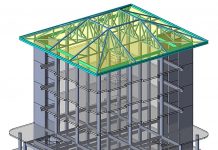Andera Al Saudi, Business Director for The BIM Hub explains how BIM provides for the accurate evaluation of design alternatives in the event of any changes that may impact the overall performance of the building
One of the main purposes of building information modelling (BIM) is to serve as the authoritative repository of original building project data (that is, data created by those contractually responsible for their generation). BIM assures that the data it contains are indeed original and are accessed in their original form and format.
It also assures that the same basic original data are available for consistent use in the evaluation of all considered design alternatives, which enables commensurate and fair comparison of them.
Evaluation
Simultaneous consideration of possible first cost reduction and the corresponding quantitative assessment of its effect on building performance allows for accurate and consistent evaluation of design alternatives.
The process assimilates the potential impact of any changed parameter on corresponding areas of the design and, consequently, the functioning of the building as a whole. In short, it provides the means to judge if cost reduction is indeed the preferable design decision to make.
The growing attention the architecture, engineering, construction, owner and operator (AECOO) industry is paying to building energy consumption has highlighted the intrinsic relationship between construction cost and energy consumption. However, the two issues are not always dealt with hand-in-hand. By deploying a process to quickly and simultaneously generate construction cost and the corresponding annual operating cost estimates for building designs, it is now possible to quantitatively assess in ‘real time’ the impact of cost based decisions on building performance.
An integrated process
We have a process to perform cost estimating and building energy performance simulation that deploys various tools (authoring, middleware and analysis), interoperating via IFC (Industry Foundation Classes) and other data formats.
The process starts when IFC-compliant BIM authoring tools populate the IFC-based BIM with building geometry data that describe a specific building. An IFC utility then calculates surface representations that delineate unique energy transmission through a construction (so-called “space boundaries”) and adds them to the representation of building geometry already contained in the BIM.
Building geometry data and data sets must typically be transformed in content and/or format (that is, reduced, simplified, translated or interpreted) before they can be used by analyses tools.
This is the function of the middleware tools. To maintain data integrity, data transformation must be performed per agreed upon rules, which are embedded in the software.
Data transformation rules vary depending on the type of analysis tool for which the transformed data are intended. Data transformation rules for building energy performance simulation would involve reading “space boundaries” and other building geometry data imported from the BIM, performing data transformation per embedded rules, and exporting transformed (as well as unchanged) data.
Data transformation would also involve the creation of thermal zone definitions, linking definitions of construction materials to the library of thermal properties, converting all data to the required syntax (relevant to the analysis tool), defining simulation run control parameters, and generating the initial input file for building performance simulation. With the use of annual weather data that are representative of the weather at the building location, this input file is sufficient to calculate thermal loads generated by the designed building.
HVAC (heating, ventilation and air-conditioning) equipment, systems and plant data, as well as internal loads and all schedules of building use and operation may need to be added manually. Ultimately, the process to import original HVAC-related data from the BIM and transform them as necessary per embedded data transformation rules would be (semi) automated.
Simultaneous to the building performance analysis, a cost estimation tool would import building geometry data from the same BIM and perform quantity take-off calculations. The take-off data can be correlated to predefined unit costs to calculate a detailed construction cost estimate for the building.
Concurrent simulation
In concurrent processes, one is able to output the total construction cost for the design and the corresponding annual operating cost that is based on local utility cost schedules (neither cost is compounded). A side-by-side comparison of the two can unambiguously show the relationship between construction and performance costs.
Data transformation rules embedded in the middleware tools are also applicable to the definition of building geometry used by analyses tools that serve other disciplines in the AECOO industry. With an additional modest effort, the diagrammed process could be adapted to simultaneously include other types of building performance, such as structural, acoustical, fire safety, egress, and more. The diagrammed process fits well with the methodology for semi-automated building energy performance simulation. The use of that methodology prevents human error, omission and contradiction when defining and setting the simulation, and protects data integrity in the reuse of original data. It also dramatically accelerates design decision-making by quickly providing up-to-date quantitative justification, shortening the overall time it takes to design and deliver buildings.
Simultaneous estimation of cost and of building energy performance, based on BIM, provides the ability to confront cost-estimate-based arguments with quantitative counter arguments that show the annual operating cost before and after cost-cutting action.
With preparatory work done in advance, design decisions based on quantitative comparison and the understanding of the particular cause-and-effect can now be reached in the same meeting – the same afternoon or the same day, depending on estimates’ complexity and building size.
This should result in better decisions, in better buildings delivered sooner and ultimately in more cost-effective building ownership than has often been the case in the past.
Andera Al Saudi
Business Director
The BIM Hub
andera.alsaudi@thebimhub.com
















